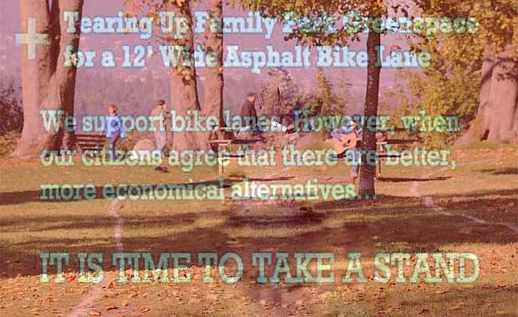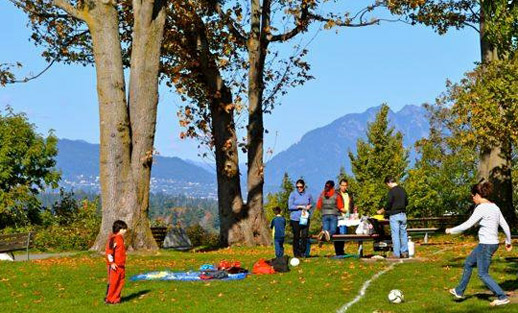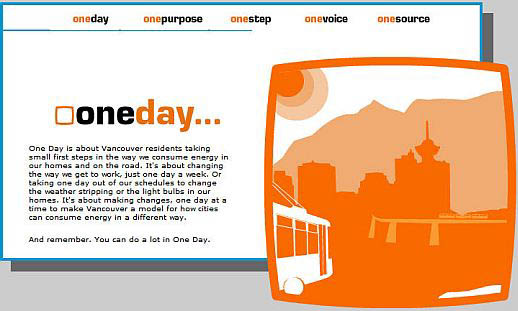
A rally to protest the imposition of a 12-foot-wide, paved bike path through Hadden and Kitsilano Beach parks will take place at NOON, this Sunday, October 20th, at Kitsilano Beach, in the area between the palm trees, adjacent to the Boathouse restaurant. Please read the post below for background information on the rally, and protest. We’ll see you there.
In July of this year, Vancouver City Council approved a bike-friendly corridor — colloquially titled the Seaside Greenway — stretching from the south end of the Burrard Street Bridge through to Jericho Park, the process achieving a critical component of a much-sought-after Vancouver bike road network.
That the Seaside Greenway plan lacked substantive detail, and was bereft of any suggestion of insight into the possible environmental impacts of the newly-approved, extended, bike route corridor stretching along Vancouver’s pristine west side waterfront, that the approved plan called for a bike route along York Avenue that almost every one of the more than 100 speakers who addressed Council opposed, that details of a proposed bike path through Hadden and Kitsilano Beach parks was utterly lacking in transparent disclosure — exorcising a goodly portion of a concerned populace — mattered not, at least for the moment, anyway.
Summer beckoned, the sun shone as it had not before, family vacations were in the offing, and the warming, sandy beaches of the west side made their siren call. The silly season had overtaken us; there was time enough down the line to consider the full implications of the decision taken by Vancouver City Council to introduce their much-desired Seaside Greenway.
Initial construction of Vancouver’s Cornwall Avenue - Point Grey Road Seaside Greenway commenced in early September with engineering changes to the south end of the Burrard Street Bridge, and the implementation of a T-intersection — the full implications of which we’re just going to have to wait to see, in practice — that will serve, all at once, to restrict vehicle access to Cornwall, prioritize and enable easier bike access, and direct most bridge traffic south along Burrard Street to Fourth Avenue, and Broadway.
Residents Oppose Paved Bike Route That Will Scar Westside Parks
Global TV. Residents speak out against 12-foot-wide paved Kits Beach bike path
Approximately two weeks ago — on Monday, October 7th — a Vision Vancouver-dominated Park Board approved $2.2 million in new bike paths along Vancouver’s westside waterfront, in support of Vancouver City Council’s Seaside Greenway “Point Grey-Cornwall Active Transportation Corridor”. Included in the approved plan were “improvements” to Hadden & Kitsilano Beach parks — an initiative that would result in the destruction of a portion of Vancouver’s natural environment, in favour of the building of an egregious 12-foot-wide asphalt bike path that would serve to all but destroy the natural beauty of two of Kitsilano’s most beloved parks.
In today’s VanRamblings’ post, we’ll attempt to present a broad cross-section of opinion on the proposed Hadden / Kitsilano Beach park bike route — from concerned neighbours, the media, Vision Vancouver and NPA Park Board Commissioners, and others — and hope to inform you of the very important issues at play in the decision taken by Vancouver Park Board on October 7th that many believe will permanently destroy a tranquil setting of natural beauty along Vancouver’s Burrard Inlet oceanfront.
This coming Sunday, October 20th, at noon, in front of Kitsilano Beach’s Boathouse restaurant — in the area nearest the palm trees — concerned citizens will rally to demand that the Vancouver Park Board reverse their decision approving a plan for Hadden and Kitsilano Beach parks that will …
- Eliminate much-needed green space, and
- Create serious new safety hazards for families, children, pedestrians, and non-cyclists who would seek to enjoy the natural beauty of the two parks
Organizers of the rally suggest that “an improper consultation process — including a lack of public engagement, advisement, consultation, public signage, and public meetings with key stakeholders” invalidates the decision taken by Park Board to approve the new 12-foot-wide, paved bike path through Hadden and Kitsilano Beach parks. Organizers further take umbrage with the City’s unparalleled rush to construction, and point out to Park Board Commissioners that the leader of the BC Cycling Association supports an alternative bike route, adjacent to the nearby roadway.
Vancouver Courier columnist Sandra Thomas reports that the “Kits Beach bike path is a done deal“, quoting Vision Vancouver Park Board Commissioner Aaron Jasper thusly …
“To be clear,” said Jasper, “this decision will not be reversed.”
In The Courier article, Thomas reports KitsFest co-founder and two time Olympian Howard Kelsey disagreeing that the public consultation was thorough, noting that many stakeholders affected by the proposed bike path were in attendance at a special ceremony on September 29th for the official Park Board opening of 10 recently-renovated Kitsilano Beach tennis courts, quoting Kelsey as saying …
“We were right there and no one said a word to any of us,” said Kelsey, who chairs Canada One Athletic Foundation and is executive vice-president of Canada Basketball. “We were completely blindsided.”
Commenting on the Save Kits Beach Facebook page, Vancouver resident Anita Sigur writes …
Now they’ve gone too far.
Slicing up the best and most untouched part of the park in order to put in a twelve foot paved bike path is absolute madness. How does cutting out the heart of this beautiful park serve to “green” the city?
The hill at the north end of Kits Beach Park is a paradise for picnickers. In a recent newspaper article (Vision Vancouver Park Board Commissioner) Constance Barnes called it a “dormant” area. Really?! If she meant a perfect spot to catch a summer nap, then I’d wholeheartedly agree. On my frequent walks there in the spring and summer I am always greeted with the sight of many contented couples and families hanging out there, making a day of it. It is the ideal spot to enjoy breathtaking views, a cool sea breeze, and some much needed shade from the enormous maple trees.
This place that they want to pave over is the destination that rewards those who walk, cycle, or arrive at the park in their cars. If you’re in a hurry to cycle some place else, I suggest you take the road. Parks are for slowing down in and drinking in their beauty. The proposed bike path not only takes away a 12-foot-wide wide swath of valuable park space, but vast amounts of park space around it that will be avoided by dog walkers, people with children, and those who don’t find it at all relaxing sitting next to what will be, in effect, a bike freeway.”
Vancouver resident Colleen Hardwick has prepared the following video …
Meanwhile, Vancouver Sun columnist Pete McMartin attributes elitist motives to those who will rally to protest the imposition of a paved bike route through the middle of two of Vancouver’s most beloved parks. McMartin writes that the west side protest represents …
“… a disturbing trend that might be demographic in nature; or it might be a symptom of the growing gulf between the haves and have-nots in the city. But it’s shrill, and it betrays a panic that has entered the public discourse.”
A very fine, a humane, writer, with all due respect to Mr. McMartin, very rarely does he get it as wrong as he gets it here. When he writes, “And whatever its route, a bike lane running through a park is not an issue.” No? Has he not watched the video above, nor personally tracked the route (someone has clearly marked the proposed bike path with chalk), as VanRamblings did this past Monday? Does he honestly believe that the faux consulting that the Vision Vancouver-dominated City Council and Park Board have engaged in (a bought-and-paid-for-by-Vision online survey — this is ‘big city’ politics of the worst kind we’re talking here) truly represents the opinions of the hundreds and thousands of cyclists who traverse the route around and through Hadden and Kitsilano Beach parks? If so, there may be a bridge he’s interested in that we could sell him for cheap.
Vancouver’s ‘rant king’, the blustery Bruce Allen, weighed in Wednesday, in his daily commentary on CKNW, taking a stand against the proposed bike route through the parks — we feel as if we’re falling down the rabbit hole here, perplexed that McMartin is taking the wrong side of the issue, while the generally frenzied Allen finds himself on the side of the angels …
On Monday, October 14th, Vancouver Sun reporter Brian Morton wrote the following story, titled “Kitsilano Beach bike route plan draws fire from critics”, quoting Kitsilano resident James Goodman …
“I don’t object to a separated bike lane,” said local resident James Goodman on Monday. “But to go right through a picnic area is ridiculous when they can easily follow the park boundary around it.”
“There wasn’t enough consultation, but there’s also not enough common sense,” added Goodman. “This is the one area of the park that’s heavily used.”
Morton also quotes Howard Kelsey, Executive VP, Basketball Canada …
“We are quite strongly shocked to see this and we knew nothing about this until last Monday,” said Kelsey, who said he represents about 3,000 basketball, tennis and beach volleyball users. “This just came out of the middle of nowhere because it was so stealthily managed. We are just so disappointed.
“We would be remiss to let them pave a 12-foot swath for a bike highway parallel to Arbutus Avenue through a highly-used recreational area beside the basketball courts that we donated and the children’s play area that Rick Hansen donated,” added Kelsey, noting that 23 parking spaces in a parking lot would also be taken away in a crowded area “where those spots are worth gold in the summer.”
Kelsey said he proposed a meeting with the Park Board on Wednesday, but hadn’t heard back. For all that, according to the Vancouver Sun, the opposition to the Hadden/Kits Beach park bike route is gaining momentum.
 |
On Wednesday morning Kelsey, and Kits Point Residents Association’s Lynne Kent, appeared on Bill Good’s CKNW talk show to express concern about the imposition of an unnecessary paved bike path through Hadden and Kits Beach parks. Click this link to hear what they had to say.
Update, Saturday morning: Howard Kelsey appeared with Jill Bennett on CKNW. Click on the audio file below to hear their discussion.
Vancouver Courier ‘Central Park’ columnist, Sandra Thomas, in a front page story published in Friday, October 18th’s Courier, has written a well-researched, balanced story, titled, “Vancouver bike path critics ready to fight, Rally against Kits bikeway planned for Sunday,” quoting the concerns of park users on the planned paved bike route. Well worth a read.
The Province newspaper has weighed in on the bike path controversy …
“You know what Vancouver needs? A lot less partisan politics at city hall. While some other large B.C. communities have municipal parties, and the ideological debates that can bring, nowhere is local politics more vicious and destructive to social cohesion and sense of community than in Vancouver. And never has that been more true than since Vision Vancouver under Mayor Gregor Robertson laid political siege to the city. It was Robertson himself who set the tone early when he was caught on microphone at a 2010 public meeting dismissing a group of concerned residents as “f—- NPA hacks.
Now Vancouver parks board vice-chairman Aaron Jasper is getting in on the act; he’s arrogantly dismissing legitimate citizen concerns about a bike lane that will cut through the heart of Kits Beach park, endangering other users, as the work of the Non-Partisan Association. He says he’ll listen to them, but it’s a done deal.
That’s the brutal partisan behaviour of Vision that so many Vancouverites have grown sick of and why they feel they have no voice. Vision’s reputation for ramming through its projects without regard to public opinion is well-established. It’s why so many now say, “I voted for Vision, but never again.” It’s also why some residents now tune out Vision proposals, which isn’t good either.
Vancouver could do with a lot more of the municipal politicians you find in smaller towns who are primarily interested in serving the public and finding compromise on issues — not turning every issue into a winner-take-all partisan fight at the expense of the majority. The city would be a much nicer place if that were true.”
Let’s hope the Vision Vancouver folks over at City Hall are listening.
![]()
![]()
![]()

For all that the more progressive forces in town tend to demonize the NPA as “that party of the right” — Vancouver’s oldest (but still thriving) municipal party, the standard-bearer of civic governance for most of the past century — over the past two years, and more, it has proved to be NPA Park Board Commissioners John Coupar and Melissa De Genova who have emerged as the Park Board Commissioners who, as persons of conscience and integrity, have steadfastly stood up for the interests of Vancouver citizens on a range of important Park Board issues, their commitment to transparency of decision-making, and democratic input from all of us who live in Vancouver, hearteningly (and dare we say, joyously) consistent.
On the NPA website, Commissioners De Genova and Coupar have called for meaningful engagement with the public on “the controversial plan to pave a 12-foot wide swath of blacktop through Kits Beach Park and Hadden Park.” Both NPA Commissioners will attend the Kitsilano Beach protest, De Genova tweeting out that she considers Sunday’s rally a “public consultation.”
Although we had written earlier that we felt it unlikely elected representatives of Vision Vancouver would attend Sunday’s protest rally, sources claim that Vision Park Board Commissioners Trevor Loke and Constance Barnes have agreed to attend. Clearly, they’ll not be in for an easy time of it — let’s try and keep the dialogue respectful, though.
The Georgia Straight has published a letter from Kitsilano resident Jason A. Johns …
I am writing to express my complete discontent with the bike lanes that are planned through Kits Beach. I’m a Kits Point resident and I am shocked that we knew nothing about the proposal.
While I approve of bike lanes, I can’t support tearing up of precious green space on a beach where families come to barbecue, and where kids throw footballs, Frisbees, play volleyball, or just run around and play.
The proposed location is dangerous to park users who are mostly pedestrians. The lane goes directly through popular picnic areas.
It is amazing to me that politicians who want Vancouver to be the “greenest city on Earth” would support such a ridiculous plan. My 13-year-old keeps asking how such a plan could be approved when it goes against all the things she has been learning at school. Even she can see the potential new danger for children playing.
Margaret Partridge has created a protest petition at Change.org, which as of Saturday evening has garnered the support of more than five hundred concerned citizens, whose signatures and commentary express concern about an environmentally unsound paved Kitsilano Beach bike path.
 On the Keep Kits Beach Wild Facebook page, there’s quite a discussion going on respecting the proposed bike route through Hadden and Kitsilano Beach parks. Perhaps the most poignant comment we’ve read in this whole brouhaha was written by Colleen Hardwick, “A tragic, destructive and unnecessary make-work project on the part of the City and the Park Board. Surely the irony of paving a park for a bike lane in the name of the “green” agenda, isn’t lost on the voting public.”
On the Keep Kits Beach Wild Facebook page, there’s quite a discussion going on respecting the proposed bike route through Hadden and Kitsilano Beach parks. Perhaps the most poignant comment we’ve read in this whole brouhaha was written by Colleen Hardwick, “A tragic, destructive and unnecessary make-work project on the part of the City and the Park Board. Surely the irony of paving a park for a bike lane in the name of the “green” agenda, isn’t lost on the voting public.”
There’s also quite a discussion going on at Voony’s Blog — a blog covering transportation issues in Vancouver, and the notion of urbanism — on the attendant issues involved in the Hadden Park – Kitsilano Beach bike route.
For VanRamblings, the issue is, as always, democracy, respect for the people, the citizenry — the families of every description who make up this expressive world of ours. Most of those who are involved in organizing the protest rally on Sunday, or who have commented on the various Facebook pages, or written letters to the newspapers, or who signed the Change.org petition, are not “political“, or have branded themselves as such, as if politics is a dirty word.
And, you know what?
Politics is a dirty word — when you have municipal parties like Vision Vancouver, the provincial Liberals or the federal Tories, each of which is given over far too often to the engagement of the politics of division, the politics of the big lie, the politics of personal destruction, the disheartening and ugly politics of malevolence and ill will, and most cynically, the politics of self-interest with which we have all become much too familiar, as we go about the daily conduct of our lives, struggle to make a living, put food on our table, care for those who are dear to us, and attempt to find joy, and — from time to time — locate oases of calm and tranquility.
Our parks are those oases of calm and tranquility, those meeting places where we connect, really connect, with our friends and our neighbours, with our families, and with those who live around us — who share our home with us — where we gain perspective on our lives, as we look across the grasses, through the trees, to the open ocean and the mountains beyond, and reflect on what it means to be us, as father, mother, sister, daughter, son and brother, aunt, uncle, grandmother, grandfather, disabled person, working person, retired person, transgendered person, gay, straight, lesbian, whatever our race or colour, whatever our heritage.
Early 20th century novelist Austen Tappan Wright, in his seminal work of fiction, Islandia, called this notion, tanrydoon, which he defined as …
How we are attuned to the environment, and to all those around us, our love of place, but also of family as they are related to that place, the absence of selfishness or purely personal interest, which is supplanted by the long view of one’s place and family across generations, the cultivation of the lands around us that become the project of generations, our parks and our open spaces as home, and the equivalent of great cathedrals, deeply tied to our love of the Earth, as an expression of our love for the natural environment, and for all those with whom we share the natural environment. We will always have the Earth, the rolling grasses and the sky, and the warmth of the sun.
If we lose the green space within Hadden and Kits Beach parks, in favour of an unnecessary and destructive paved bike path, we will lose a bit of ourselves, our history, and our legacy to the generations that are to follow.
At noon, on Sunday, October 21st, a few hundred good people will gather together at Kitsilano Beach to say, “This is our Earth, this is our natural environment, our green space, where we might enjoy the company of our neighbours and friends and family, our park as an oases of tranquility in our otherwise, too often, frenetic lives. We, all of us, do not want nor do we need a ragged, unforgiving asphalt bike path cutting through our park.”
Photos of Hadden & Kitsilano Beach parks, taken by Elvira Lount, Oct. 13, 2013.
Colleen Hardwick takes a walk along Ogden Avenue, from Chestnut to Maple and through Kits park, showing the existing provisions for bicycles, as well as cars, school buses, dog-walkers, roller-bladers, and other park users. Oct. 18, 2013.
Hope to see you at Kits Beach, noon, on Sunday. At some point, we must take a stand. Sunday just may be the starting point of change.



